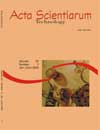<b>Evaluation of an activated sludge reactor applied to nitrification using kinetic assays</b> - DOI: 10.4025/actascitechnol.v30i1.3201
DOI:
https://doi.org/10.4025/actascitechnol.v30i1.3201Keywords:
nitrification, activity assay, activated sludge, kinetic models, inhibitionAbstract
In this work, an activated sludge lab-scale reactor used for nitrification was monitored by specific activity kinetic assays. The nitrification biomass activity was carried out by respirometric methods in order to characterize the inoculum and the reactor sludge after two different operation conditions: during the feeding of the reactor with synthetic autotrophic medium, and after feeding it with effluent from an UASB reactor used for denitrification. The efficiency of nitrification reached 90% in both operation conditions. Results obtained by the kinetic activity assays were better adjusted by the kinetic model of Andrews, which includes the inhibition constant by the substrate (Ki), than the Monod model. However, an increase was observed in the inhibition constant (Ki) of the sludge after the operation of the reactor as compared with the inoculum. This effect demonstrates an adaptation of the biomass to the new nitrification conditions (loading rate).Downloads
Download data is not yet available.
Downloads
Published
2008-05-08
How to Cite
Reginatto, V., Santana, F. B., Schmidell, W., & Soares, H. M. (2008). <b>Evaluation of an activated sludge reactor applied to nitrification using kinetic assays</b> - DOI: 10.4025/actascitechnol.v30i1.3201. Acta Scientiarum. Technology, 30(1), 49–55. https://doi.org/10.4025/actascitechnol.v30i1.3201
Issue
Section
Chemical Engineering
License
DECLARATION OF ORIGINALITY AND COPYRIGHTS
I Declare that current article is original and has not been submitted for publication, in part or in whole, to any other national or international journal.
The copyrights belong exclusively to the authors. Published content is licensed under Creative Commons Attribution 4.0 (CC BY 4.0) guidelines, which allows sharing (copy and distribution of the material in any medium or format) and adaptation (remix, transform, and build upon the material) for any purpose, even commercially, under the terms of attribution.
Read this link for further information on how to use CC BY 4.0 properly.











8.png)




